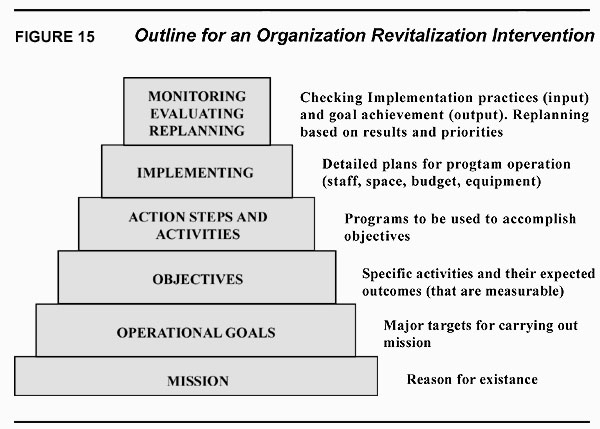Action Planning
The action planning phase of an intervention consists
of laying out the specific procedures or activities that will most likely
achieve the agreed upon priority goals. These plans will describe who is doing
what, when and where and requiring what resources. This detailed planning is
often turned over to a planning or steering committee to work out. When the
proposed plans are completed—there is often more than one approach to the
achievement of the goal—they are presented to the stakeholders for modification
and ratification.
It is vital that the final plan describes objectives and activities that can be monitored as the implementation starts. This includes a very dear time line (what is supposed to happen when) intended outcomes along this time line. Figures 15 and 16 show the layout of a typical project for a human service organization and examples of project success indicators are shown in the program evaluation chapter. It is important to extensively involve the stakeholders at this phase, especially if a steering committee has done the work.

Sessions involving the stakeholders can be built
around the following design:
-
Introduction of the plan(s) and the rationale for
them.
-
Clarification oriented questions and discussion
of the plans (very brief).
-
Brainstorming a list of the strengths of the
plan(s).
-
Brainstorming a list of the weaknesses of the
plan(s).
-
Brainstorming suggestions to improve the plan
either by building on its strengths or especially by reducing the impact
of its weaknesses.
-
Arranging for next steps to brush up the plan and
start its implementation.
It is assumed that the lists would be analyzed by the
steering committee and used to make appropriate modifications in the plan. If
serious resistance to the plan surfaced, another round of consideration might
be worth it to increase stakeholder commitment and the credibility of the plan.
The major features of the action planning phase of the
ICC model start with who is to do what, when and where, and necessary
resources. Following these basics special attention is given to:
-
How can we effectively involve the stakeholder in
this action planning phase?
-
How can we reduce the resistance or restraining
features of the action plan?
-
Who are the appropriate people to champion the
implementation of various parts of the plan (people who will lead and be
responsible for the activities)?
Another consideration is dealing with the 5th
Assumption About Changing Social Systems, namely 'change
in one part of a system will produce strain in related parts and require
changes in them.' This means figuring out who the people or sub groups in this
system or in related systems are, that will be impacted by the plan over time
and establishing some contingency strategies to deal with them.
|
FIGURE 16 |
Sample
Revitalization Planning intervention |
|
|
YM-YWCA
Example |
||
|
|
The development of well
rounded, self actualized individuals. |
|
|
Goal: |
To establish sound
physical health practices with children and youth. |
|
|
Objective: |
To provide a routine and
expectations for at least 30 minutes of exercise, three times a week. To provide an
understanding of basic Canadian minimum nutritional requirements. |
|
|
Action Steps: |
To initiate and operate 5 physical health programs
for children and youth (6-16) in decentralized areas.
(Standards)
·
in each of 8 major areas of the city.
·
for a minimum of 15 participants per
location participating 2-3 times a week.
·
within the next six months. · at a cost of $3,000 per location per year. |
|
|
Implementation: |
Show a plan for staff and volunteer operation of the
eight programs, and how the programs will be assessed.
Show a plan for budget, equipment, space rental
needed for implementation. |
|
|
Monitoring &
Evaluating: |
Were the 8 programs set up with the planned quality
and focus of the program? |
|
|
Replanning: |
How much progress did the participants make toward
the stated objectives of the program? Are any hard data avail-able on
objectives of exercise and nutrition?
What should be the next steps in replanning this
program?
And what should be its place in overall Y
priorities? |
|
The final consideration of the
action planning stage relates to the usual lull or slow down of momentum
that takes place shortly after implementation has started. This is the point
where interventions most frequently break down. It is a challenge to keep the
stakeholders involved during early implementation and the new ways of doing
things take a while to catch on. Or to put it differently, identifying needs,
collecting and analyzing data, and goal setting and action planning are
intellectual activities that are fun. Implementing action plans requires new
behaviour that is stressful and perhaps unpleasant. Ideas are a dime a dozen,
as I say, its the implementation that counts.
Definite procedures with realistic time frames to
monitor the 'doing' phase should be incorporated into the action planning.
Provisions should be made to modify the plans if they are not meeting
expectations or to switch to an alternative back up plan.
And
if they are meeting expectations, celebrations involving all the stakeholders
have been incorporated into the action plan.
Next Section - Action Taking